
Dean Paul Martin was an American singer, actor, and comedian. One of the most popular and enduring American entertainers of the mid-20th century, he was nicknamed "The King of Cool." Martin gained his career breakthrough together with comedian Jerry Lewis, billed as Martin and Lewis, in 1946. They performed in nightclubs and later had numerous appearances on radio and television and in films.
3D films are motion pictures made to give an illusion of three-dimensional solidity, usually with the help of special glasses worn by viewers. They have existed in some form since 1915, but had been largely relegated to a niche in the motion picture industry because of the costly hardware and processes required to produce and display a 3D film, and the lack of a standardized format for all segments of the entertainment business. Nonetheless, 3D films were prominently featured in the 1950s in American cinema, and later experienced a worldwide resurgence in the 1980s and 1990s driven by IMAX high-end theaters and Disney-themed venues. 3D films became increasingly successful throughout the 2000s, peaking with the success of 3D presentations of Avatar in December 2009, after which 3D films again decreased in popularity. Certain directors have also taken more experimental approaches to 3D filmmaking, most notably celebrated auteur Jean-Luc Godard in his film Goodbye to Language.
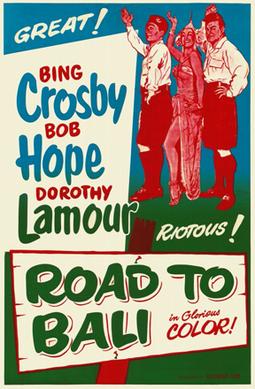
Road to Bali is a 1952 American comedy film directed by Hal Walker and starring Bing Crosby, Bob Hope, and Dorothy Lamour. Released by Paramount Pictures on November 19, 1952, the film is the sixth of the seven Road to … movies. It was the only entry in the series filmed in Technicolor and was the first to feature surprise cameo appearances from other well-known stars of the day.

Scared Stiff is a 1953 American horror paranormal semi-musical comedy film directed by George Marshall and starring Dean Martin and Jerry Lewis. One of the 17 films made by the Martin and Lewis team, it was released on April 27, 1953 by Paramount Pictures. It is the fourth screen adaptation of the 1909 play The Ghost Breaker by Paul Dickey and Charles W. Goddard, previously filmed under that title in 1914 and 1922 and as The Ghost Breakers in 1940.
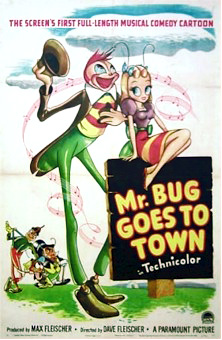
Mr. Bug Goes to Town is a 1941 American animated Technicolor feature film produced by Fleischer Studios, previewed by Paramount Pictures on December 5, 1941, and released in California and New York City in February 1942. The film was originally intended to be an adaptation of Maurice Maeterlinck's The Life of the Bee, but the rights could not be attained, or more rightly, Paramount was unwilling to purchase them from Samuel Goldwyn. Instead, they fashioned and crafted an original modern story loosely inspired on the book.

Nothing Sacred is a 1937 American Technicolor screwball comedy film directed by William A. Wellman, produced by David O. Selznick, and starring Carole Lombard and Fredric March with a supporting cast featuring Charles Winninger and Walter Connolly. Ben Hecht was credited with the screenplay based on the 1937 story "Letter to the Editor" by James H. Street, and an array of additional writers, including Ring Lardner Jr., Budd Schulberg, Dorothy Parker, Sidney Howard, Moss Hart, George S. Kaufman and Robert Carson made uncredited contributions.

The Benchwarmers is a 2006 American sports-comedy film produced by Revolution Studios and Happy Madison Productions, distributed by Columbia Pictures, directed by Dennis Dugan, written by Allen Covert and Nick Swardson, and starring Rob Schneider, David Spade and Jon Heder with Jon Lovitz, Craig Kilborn, Molly Sims and Tim Meadows in supporting roles. It tells the story of three nerds and a billionaire forming the titular baseball team to take on the little league baseball teams.

Man in the Shadow is a 1957 American CinemaScope crime Western film directed by Jack Arnold and starring Jeff Chandler, Orson Welles, Colleen Miller and Ben Alexander.

The Caddy is a 1953 American semi-musical-comedy-sports film starring the comedy team of Martin and Lewis. It is noteworthy for Dean Martin introducing the hit song "That's Amore".

Top Banana is a 1954 American musical film based on the musical of the same name, starring Phil Silvers, and featuring Rose Marie, Judy Lynn, Jack Albertson and Joey Faye, all of whom reprised their roles from the Broadway production of the musical.
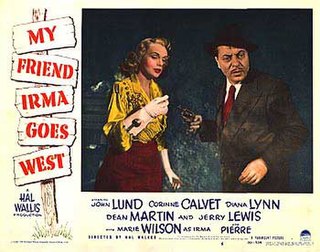
My Friend Irma Goes West is a 1950 American comedy film directed by Hal Walker and based on the radio show My Friend Irma. It stars the comedy team of Dean Martin and Jerry Lewis. The film is a sequel to My Friend Irma (1949) and was released on May 31, 1950 by Paramount Pictures.
The Stooge is a 1952 American comedy film directed by Norman Taurog and starring the comedy team of Martin and Lewis alongside Polly Bergen and Marion Marshall. The film was released nationally in the United States in February 1953 by Paramount Pictures.
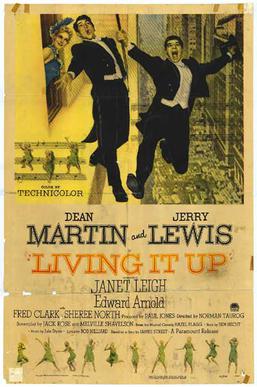
Living It Up is a 1954 American comedy film starring Dean Martin and Jerry Lewis which was released by Paramount Pictures.

3 Ring Circus is a 1954 American comedy film directed by Joseph Pevney and starring Dean Martin and Jerry Lewis. The picture was shot from February 17 to March 31, 1954, and released on December 25 by Paramount Pictures. The supporting cast includes Joanne Dru, Zsa Zsa Gabor, Wallace Ford, Sig Ruman, Nick Cravat, and Elsa Lanchester.

Jamboree, known as Disc Jockey Jamboree in the United Kingdom, is a 1957 American rock and roll film directed by Roy Lockwood. Its story is about a boy and girl, Pete Porter and Honey Wynn, who become overnight sensations as a romantic singing duo who run into trouble when their squabbling managers, try to turn them into solo acts. Against this backdrop in cameo performances appear some of the biggest names of rock and roll in the 1950s lip-syncing to their recordings.

Pardners is a 1956 American comedy western film starring the comedy team of Martin and Lewis. It was released on July 25, 1956, by Paramount Pictures.

Westward Ho the Wagons! is a 1956 American Western film starring Fess Parker and Kathleen Crowley and produced by Walt Disney Productions. Based on Mary Jane Carr's novel Children of the Covered Wagon, the film was produced by Bill Walsh, directed by William Beaudine, and released to theatres on December 20, 1956 by Buena Vista Distribution Company. The supporting cast features Jeff York, Sebastian Cabot, David Stollery, and George Reeves.

I Love Melvin is a 1953 American Technicolor musical romantic comedy film directed by Don Weis, starring Donald O'Connor and Debbie Reynolds. According to MGM records, the film earned $1,316,000 in the United States and Canada and $654,000 overseas, resulting in a loss of $290,000.
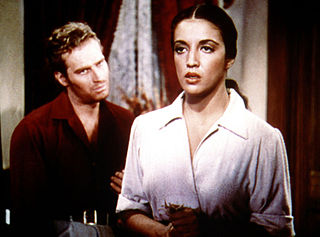
Arrowhead is a 1953 Western Technicolor film directed by Charles Marquis Warren, starring Charlton Heston, and featuring a supporting cast including Jack Palance, Katy Jurado, Brian Keith and Milburn Stone. The picture is based on the novel Adobe Walls by W. R. Burnett. The screenplay was also by Charles Marquis Warren.
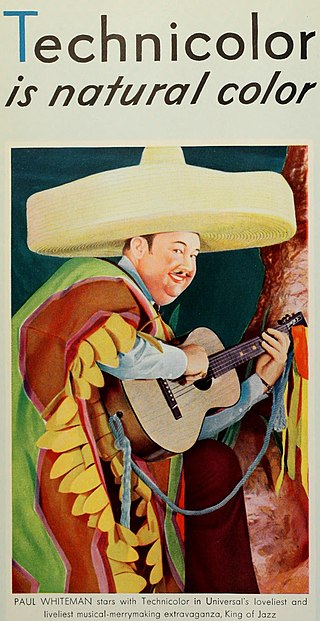
Technicolor is a series of color motion picture processes, the first version dating back to 1916, and followed by improved versions over several decades.


















